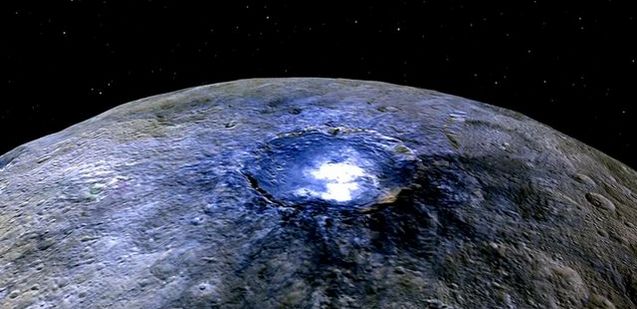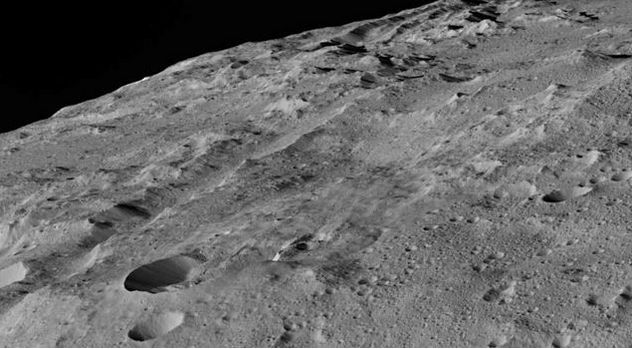
On Monday, December 21st, the private space launch company SpaceX achieved a remarkable first in the annals of space flight: they successfully launched a payload carrying rocket into orbit, and then returned its first stage to a safe landing back on Earth, close to its original launch point.
The Falcon 9 rocket, in its first launch since June 2015 when a fuel tank failure lead to the vehicle’s destruction together with the Dragon resupply vehicle it was lifting to the International Space Station, was lifting a total of 11 communications satellites into orbit on behalf of Orbcomm.
The booster lifted-off from Florida’s Cape Canaveral Air Force Station at 20:29 EST on Monday, December 21st (01:29 UTC, Tuesday December 22nd). At 2 minutes 27 seconds into the flight, having pushed the vehicle through the densest part of the atmosphere, the first stage engines shut down, and shortly afterwards, the first and second stages separated, allowing the latter’s Merlin engine to ignite.
As the second stage continued to accelerate up to deployment orbit, the first stage coasted upwards before using cold gas thrusters to effectively “flip” the booster around so it could use the first in a series of “boostback burns” of its main engines to slow itself down as well as pushing it back towards Cape Canaveral.
With this completed, the booster used the cold gas thrusters to again flip itself over so it would be descending engines first towards the ground, performing two further “boostback burns” to control its descent before making a final engine burn during the last few dozen metres of the descent and deploying its 4 landing legs and steering vanes for a successful touch down some 10 minutes after lift-off, which was captured by cameras on the ground and aboard an observing helicopter.
The SpaceX success came less than a month after Blue Origin, the private space company founded by Amazon billionaire Jeff Bezos, also landed the initial stage of their New Shephard launch system following a test launch. However, the latter is not intended to achieve orbital velocities at present, and so the booster stage – referred to as the “propulsion module” by Blue Origin – was not travelling nearly as fast as the Falcon 9 first stage, nor did it have to perform the complex “boostback” manoeuvres.
In the meantime, the second stage continued upwards, successfully deploying the Orbcomm satellites into LEO – low Earth orbit, at around 630 kilometres (just under 400 miles) altitude. With this part of the mission completed, the second stage booster also re-ignited its main engine, allowing it to achieve a geostationary transfer orbit and coast phase.
This was as important as the first stage landing because, while existing Falcon 9 rockets are capable of placing large payloads into geosynchronous equatorial orbit, some 36,000 km (22,000 miles) above the surface of the Earth, it has required the first stage of the rocket to do much more of the work, leaving it with insufficient fuel reserves to attempt a return to Earth and landing. The uprated second stage, tested as a part of this flight, alleviates the first stage of some of the booster phase work, allowing it to retain the fuel it needs to make a successful return to Earth.
The overall hope with the upgraded Falcon 9 and the new landing facilities at Cape Canaveral, is that they will allow SpaceX to lower launch costs to the benefit of customers, and allow them to make more efficient use of their boosters rather than just tossing them away into the Atlantic or Pacific after a single use.
However, even with this first successful landing, the company still has some significant hurdles to clear. One of these will be demonstrating it can refurbish used first stages at a fast enough pace to be able to maintain a launch cadence high enough to be attractive to commercial operators looking for launch opportunities, rather than risking them look to those companies able to offer a faster launch rate.
Nevertheless, SpaceX’s achievement is clear, and after the disappointments in trying to recover the Falcon 9 first stage at sea (initially seen as a “safer” option due to the negligible risk of civilian injuries if anything went wrong when compared to returning a rocket to Earth near populated areas), deserves every congratulation.
Dawn over Ceres

Dawn, the NASA / ESA joint mission currently mapping Ceres, one of the solar system’s three “protoplanets” located in the asteroid belt between the orbits of Mars and Jupiter, reached its lowest planned orbital altitude in early December, ready to start the final phase of its mission.
The new orbit, just 385 km (230 miles) above Ceres mains the craft can image the surface at a resolution of 35 metres (120 feet) per pixel.
Of particular interest to the science team has been determining the mysterious bright patches seen within the crater Occator during Dawn’s approach to Ceres and during its higher mapping orbits. While perhaps the largest found, the bright spots in Occator are not alone – around 130 bright spots have been located, almost all of them within Ceres’ craters, and analysis now shows that the material seems to be consistent with salts, such as sulfates, with silicate materials also very likely present.

Another curiosity seen on Ceres is a series of troughs and grooves, some very prominently running close to a chain of craters called Gerber Catena. such grooves and troughs are not uncommon around impact sites, but with Ceres, some of them seem to be more akin to features commonly associated with tectonic activity, a reflection of internal stresses occurring within Ceres. This is somewhat unusual for a body of this size, and again points to many of the smaller bodies of the solar system being a lot more complex in their history and formation than may have been thought.
As well as the indications of possible tectonic activity at some point in Ceres’ history, science teams also believe they have found evidence for ammoniated clays on Ceres. This is again interesting, as ammonia is more abundant in the outer solar system, suggesting Ceres may have formed much further from the Sun, possibly towards the orbit of Neptune, and slowly spiralled inwards, or it formed in place where ammonia-rich material had migrated from the outer solar system.

Like Pluto, Ceres seems to be offering up as many new mysteries as Dawn starts to answer long-standing questions about the smaller bodies of the solar system, encouraging planetary scientists to re-examine ideas and theories. A point not lost on Dawn’s Principal Investigator, Chris Russell, who notes, “as we take the highest-resolution data ever from Ceres, we will continue to examine our hypotheses and uncover even more surprises about this mysterious world.”
NASA May Not Get Insight On Mars
In June I wrote about NASA’s upcoming next mission to Mars, the Interior Exploration using Seismic Investigations, Geodesy and Heat Transport (InSight) lander mission. This is intended to probe the deep interior of Mars, increasing both our understanding of Mars and also the processes that shaped the rocky planets of the inner solar system (including Earth) more than four billion years ago.

Originally slated for a March 2016 launch, the mission has now been pushed back until at least 2018 – and may not in fact fly at all. This is because of a persistent fault in one of the science instruments which should be a part of the US $475 million mission.
The French-developed seismometers package, which forms a core part of the mission’s science package, first hit problems in August when welds on the unit’s vacuum sphere – a critical part of the instrument – kept failing. Attempts to correct the issue have consistently led to further problems, the latest occurring in December, when the unit was due to be integrated into the lander. This means the unit must be returned to CNES, the French Agency for further repairs or possible replacement. Either way, it means the unit would not be ready in time to be integrated and tested in time for the lander to meet the 26-day launch opportunity window, which opens on March 4th, 2016.

As a result, the lander – which had already been shipped to Vandenberg Air Force Base, California, where it would have been the first Mars mission ever launched from the US West Coast – has now been returned to Lockheed Martin, the vehicle’s manufacturer, where it will be properly stored for two years.
This is because optimal launch opportunity to Mars only occur once every 26 months, so with the March 2016 opportunity now a non-starter, InSight will have to wait until around June 2018 for its next launch opportunity. And even then, there is no guarantee the mission will fly. InSight is financed under NASA’s Discovery programme, and missions under that banner are cost capped. The extra time in storage could result in the mission exceeding its budget, putting it at risk of cancellation.
‘Phone Home … ‘Phone Home … But Dial the RIGHT Number …
After helping crew mates Tim Kopra and Scott Kelly of NASA perform a space walk to repair the space station’s “mobile transporter”, British astronaut Tim Peake managed to do something which is likely to have his mission aboard the International Space Station remembered for some time – if not for entirely the right reason.
While attempting to ‘phone home on Christmas Eve, he dialled the wrong number. Expecting a member of his family to answer the call, he said, “Hello, is this planet Earth?” – much to the bemusement of the woman who answered the call and who had no idea what it was about.
Following the error, which came on top of having to leave a voicemail for his parents as they were out when he made a previous call, Major Tim offered an apology over Twitter:

2015 was a memorable year for space, with many firsts. We saw Pluto in details for the first time, Ceres too, and the first orbital rocket coming back to home, landing by its own. I felt the enthusiasms of the people jumping for joy. I agree that while Blue Origin was remarkable, it can’t entirely compare with SpaceX achievement, as there is a different order of magnitude. Musk told it will take “a few years” before they will “figure out how to make the reuse as easy as possible. So that really no work is required between reuses, apart from refilling the propellant tanks”. It will be game changing accomplishment, and this one was a milestone, hopefully in the right direction and not ending like the Space Shuttle. Musk isn’t just a dreamer: he has a long term vision, while he is less subject to alternating US administrations; so SpaceX has good planning and their launches are even profitable, while they test new stuff and look forward. For sure it was really amazing to see it and an awesome Christmas gift for all the space enthusiasts all over the globe.
The next year we won’t see InSight. It’s better they found the issue now and not on Mars. I just hope they won’t waste all the money they spent and a mission that was almost ready. If I was them, I’d rather renounce to a pair of F-35, instead of scrubbing this mission. Or it would be a short-sight.
LikeLike